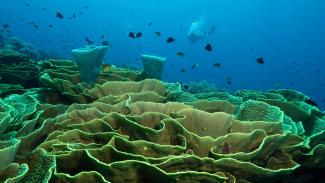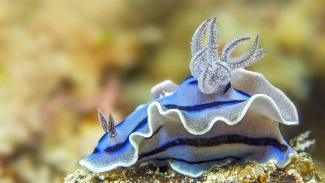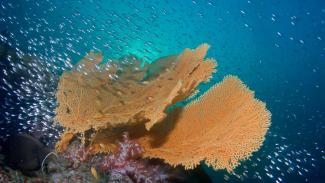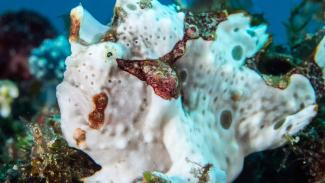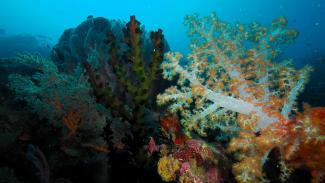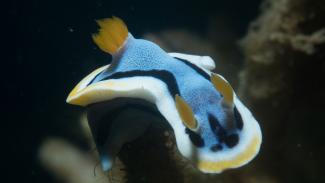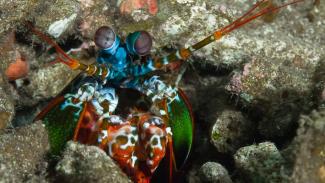
Milne Bay can be found at the south-eastern tip of mainland Papua New Guinea, separating the Soloman Sea from the Coral Sea to the south.
It is a beautiful & charming place, with lush mountains, lovely beaches, picturesque villages and friendly people.
The surrounding area, encompassing numerous island groups both to the north & the south, is one of the country’s first & most famous dive spots & the original home of ‘muck-diving’.
Highlights
Best diving spots
In the northern tip of Milne Bay, Banana Bommie is a hugely popular dive site. This large bommie rises to within a few metres of the surface and is covered in life. Batfish & Trevally hang in the current, while many smaller critters can be found on the bommie itself. Grey Reef Sharks are sometimes seen too.
Around the northern tip of Milne Bay are three fantastic sites. Dinah’s Beach is the world’s original muck-diving site. The shallow, black sandy slope is home to all manner of fascinating critters - Seahorses, many Octopi, Dwarf Lionfish, Frogfish, Juvenile Batfish and many species of Scorpionfish.
Close-by, Deacon’s Reef provides is a kaleidoscope of colour & life. Immense coral pinnacles rise from the depths to within 10m of the surface, carpeted with a myriad of beautiful, pristine corals that hide countless numbers of small, colourful reef fish & invertibrates.
Further along the coast, Wahoo Point is a great site for big fish action. Hammerheads, Manta Rays & Whalesharks can be seen here and even Dolphins, Minke Whales & Killer Whales have been known to pay a visit. Further west on Cape Vogel is a site known as Black Jack, where one of the world’s best preserved plane wrecks can be found. Coming to rest on the bottom of the sea in 1943, this large, four-engined WWII plane sits exactly upright and is completely intact, with all engines and loaded gun turrets still in place. The water here tends to be very clear, so despite sitting in over 30m of water the wreck can often be seen in its entirety. It is now encrusted with lovely corals and is home to plenty of interesting marine life.
For macro lovers, Observation Point on Normanby Island to the north is also a must. Mangrove, Sea-grass and rubble don’t make for the most beautiful diving, but they hide a treasure trove of unusual marine life including Juvenile Batfish, Seahorses, Mimic Octopus, Spanish Dancers, Coleman’s Shrimp & Snake Eels.
To the south, Giants at Home is a shallow protected bay where Manta Rays come to be cleaned. Up to 15 of these graceful creatures - normally around 3-4m across - line up to get cleaned over a coral bommie in just a few metres of water, providing outstanding photo opportunities.
For thrill seekers, The Washing Machine in China Strait is a must. The strait was named by John Moresby, the first European to chart these waters, who thought he had found a short-cut to China. This passage receives ripping currents, which provide a short, but thrilling drift dive for experienced divers.
There are so many dive sites around the Milne Bay area that it would take many visits to do them all justice. In addition to those described above, Pelagic Point, Michelle’s Reef, Kathy’s Corner, Crinoid City, Cherie’s Reef & Cobb’s Cliff are also outstanding sites.
When to dive
The area can be dived all year round, with November to February bringing the very best diving conditions and May to September bringing the heaviest rainfall.
Getting there
There is a small airport 40km outside Alotao that connects with Port Moresby to the west. Air Ninguini run a couple of flights each day.
Activities
It is possible to arrange sight-seeing trips from Alotoa to explore the surrounding jungle or visit WWII wrecks that are dotted around the region. As with other parts of PNG, the local villages, peoples & cultures are very interesting too.
Resort and liveaboard options
Liveaboard operators in Milne Bay tend to base their arrival & deperature times around Air Ninguini's flights, so many divers do not actually need accommodation in Alotoa itself. For those that do, Tawali is the best option.


